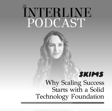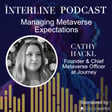Become a Creator today!Start creating today - Share your story with the world!
Start for free
00:00:00
00:00:01

The Infrastructure For Traceability, With Avery Dennison
The Interline spoke with the Head of Enterprise Sustainability at Avery Dennison about how the company is working to optimise labour and supply chain efficiency, reduce waste, advance sustainability, circularity and transparency, and better connect brands and consumers.
More in our sustainability archives: https://www.theinterline.com/category/fashion-sustainability-articles/
Transcript
Introduction to Consumer Recycling Challenges
00:00:03
Speaker
Maybe the bigger challenge is the infrastructure that goes in front of recycling. So how can a consumer get a their garment that they wish to recycle back into a recycling stream? Today, we don't have large scale technologies or supply chains to allow a consumer to do that.
Podcast and Guest Introduction
00:00:28
Speaker
Hello everyone and welcome to the Interline Podcast. Today I'm talking to Mike Colarossi, Head of Enterprise Sustainability at Avery Denison. The company is a leading global material science and digital identification solutions provider with locations in over 50 countries and around 35,000 employees worldwide.
00:00:49
Speaker
Their solutions can be used to optimize labor and supply chain efficiency, reduce waste, advance sustainability, circularity and transparency, and better connect brands and consumers.
Mike's Career and Sustainability Focus
00:01:00
Speaker
Now, a little more about our guests on today's episode. Mike previously served as the Vice President of Innovation, Product Line Management and Sustainability. He joined the company in 2013 and has been engaged in sustainability for the past 25 years.
RFID and Digital IDs in Fashion Sustainability
00:01:15
Speaker
Being in the space for so long, Mike was able to offer a unique and informed perspective on many of the most critical issues around sustainability in the fashion industry today.
00:01:25
Speaker
and the ways in which technology can play a part. In our conversation, we discuss a range of topics, starting with Avery Denison's technology solutions, from radio frequency identification, RFID tags and inlays, to software platforms, Why digital IDs are so important for the fashion industry right now. We also delve into circularity and who bears the responsibility for the full-term impact of a garment and how far the industry still needs to go when it comes to recycling and much more. Now over to my interview with Mike. Welcome, Mike. Thanks, Emma. It's great to be here. I'm glad this worked out. Amazing. um Could you start with introducing yourself, talking a bit about your career path, as well as a little bit about what your day-to-day looks like at Avery Dennison?
00:02:10
Speaker
Sure. I've been in industry unbelievably now, uh, 25 years. I didn't start in the apparel space. I actually started my career in the chemical industry, um, where I spent about 15 years always on the product and technology side of the business. I joined Avery Dennison now about 11 years ago. ah first starting in RFID technology, and over the course of the last 10 to 11 years have built up my portfolio of knowledge within the business to the point now where I am responsible for leading innovation, product management, and sustainability for the full breadth of our apparel portfolio.
Global Experiences and Career Impact
00:03:03
Speaker
I've been fortunate to live in multiple different parts of the world. um I spent about seven years of my career living in Shanghai, China, which was an amazing experience. And I would um describe myself as a possibleist, and that's maybe a self-description, ah but but I believe that most things are possible. it It's nothing is ever really easy, particularly those things that are are worth achieving. ah But I do believe in in hard work and technology and innovation to ensure that that we make things possible going forward. For sure. That's so interesting you lived in Shanghai for you said seven years. um Where else have you lived? Can you mention, I just think it it does play a part in how
00:03:59
Speaker
your career with technology has unfolded, most likely.
RFID Tech and Circular Economy
00:04:03
Speaker
Yep, I started my career living in the Midwest in the United States. um Then I lived in Shanghai ah for those seven years. I always say that I feel like I've lived through the second industrial revolution. I was there at the time when the Chinese economic machine was really starting to to advance and accelerate from 2002 to 2009. um
00:04:30
Speaker
I actually lived for a brief time in Hong Kong as well. um my My son was actually born there. And then after ah my stint in Asia, I returned to the United States, um of all places I lived in Louisville, Kentucky, um and now I'm based in Boston. And over the course I've traveled, I've spent a lot of time in in Europe ah in particular, um given Avery Dennison's presence there, but also given my previous employer's presence and in Europe as well. Fantastic. um Now talking a little bit about the technology, um
00:05:06
Speaker
You just mentioned RFID. So a lot of the work you do is targeted at creating item level identity using that technology. So RFID tags and inlays, software platforms, packaging and display information. Can you walk us through why that sort of identity is so important right now from upstream traceability to the end oflife of life of products and why you think RFID is the right infrastructure to be building on top of? Absolutely. yeah And you are correct. Avery Denison is the world's largest producer of ultra high frequency RFID. And we incorporate that into a number of our apparel products. RFID technology was adopted by the apparel industry on the business case of inventory visibility and supply chain efficiency.
00:06:02
Speaker
And over the last decade, it really has penetrated the industry with that use case to try to identify opportunities to reduce inventory where possible, but also, and probably most importantly, ensure that consumers um and are able to get the product they want, where they want it, and when they want it, and to ensure that that brands and retailers have that product at that at that point for for the consumer. so So it's now been adopted at somewhere, I would say, 40% to 50% penetration within within the apparel industry. I wouldn't call it ubiquitous, but it is it is certainly starting to to get to a critical mass. um As we go forward,
00:06:54
Speaker
ah RFID technology is going to be absolutely essential in terms of being able to communicate not only inventory information to to brands and retailers, but also as as we think through the the supply chain, um being able to drive things like Omnichannel. When the pandemic hit,
Tech for Connectivity and Traceability
00:07:15
Speaker
buy online, pick up and store was made a lot more efficient ah through RFID technology because brands and retailers understood where that product was in their and their supply chain. They could immediately ship it ah to to the location that was that was required. um as As we go forward, as we think about sustainability and the circular economy,
00:07:41
Speaker
we will We will see RFID technology particularly as it gets more incorporated into garments and can survive the life of garments. It will be used to enable things like automatic sortation for recyclers as as more garment-to-garment recycling becomes prevalent within the industry. It will allow us to create um resale platforms by which by which resellers can can understand where that product is at any point in time in their inventory and get it to a consumer. um So RFID technology um initially was adopted on the supply chain premise. As it becomes more penetrated, it will start to have additional use cases. We already see it now with things like self-checkout.
00:08:33
Speaker
where several retailers use RFID technology to to drive self-checkout that many of us as consumers now are getting accustomed to to driving. But I don't want your listeners to think that it's just RFID technology alone. It really is this idea of assigning a unique digital ID to a textile and then assigning data to that. So RFID is fantastic for business-to-business use cases. But but for business-to-consumer or consumer-to-consumer, we'll need technologies like near-field communication, NFC, or QR codes, or other sensor technologies that Avery Denison is currently developing.
Shared Responsibility in Garment Lifecycle
00:09:18
Speaker
to incorporate those into products as we go forward, to allow that brand to consumer or the consumer to consumer connectivity, and then to be able to populate that those those those products with unique data on where it was made, what what was it made of, um how can I recycle and resell it? um How can I actually ah ensure that this is an authentic good when it's on a resale platform? all of those use cases can be unlocked through digital IDs. Thanks for making that clarification. I think that's really important. And it leads on to my next question, which is about all those groups you spoke about. It's about suppliers, brands, consumers, recyclers, service companies who might benefit from using this type of technology. Where do you think the responsibility lies for the full impact of a garment? Oh, that's a tricky question.
00:10:17
Speaker
i know I know right now the trend, particularly from governments in Europe and we're seeing it in the United States as well, is to put that onus on the brand. Frankly, I think that's an overly simplified answer ah to to to the problem ah that that the industry is facing. I do think it is ultimately ah the responsibility of everyone in that supply chain, whether it is the brand, the retailer, the actual manufacturer of the garment, or the consumer,
00:10:58
Speaker
to to be able to um address the challenges that that many of the laws that are coming in to force around extended producer responsibility are targeting.
Digital Product Passports
00:11:11
Speaker
it's It's easy to say the brand ah is is responsible, but the brand is going to need all of its supply chain partners to be able to inform a consumer um how to recycle a garment and to inform its supply chain around how to optimize inventory to ensure that it is not overproducing. um So it may be a bit of a cop-out answer, but but I do think it is it is everyone across that supply chain that that's that's responsible. and And to target a single group, I think may be misguided. No, that makes a lot of sense. um I think you're right. it's not
00:11:55
Speaker
It's not about one, it's it's about all. um And I guess I'm asking some difficult questions here that I myself would like the answer to. um The next one is really about what is going to be something that really moves the needle when it comes to sustainability in fashion and the circular economy. So in this context, I'm talking about digital product passports. um and because I was researching and I know Avery Denison has a new service. um It's the digital product passport as a service platform. And as a product, it's aiming um for a few very sought after objectives, which is that it's standardized, interoperable. um The product data transcends the traditional limits of traceability. It's a turnkey platform for brands and retailers. And I'm just wondering,
00:12:49
Speaker
Is this the kind of thing that you think is going to really make a difference or is it something else? So I think digital product passports will be the start of an evolution towards creating more digitized garments in in in the future. it's It is a first effort around assigning a additional data to garments in a digital way. And and Avery Dennison's digital product passport as a service is an on-demand platform that will comprise hardware, digital ID technology, the physical label itself, our our knowledge and support of the space to help brands and their supply chains comply with the European digital product passport.
00:13:49
Speaker
legislation. So I think it's a start. I i fundamentally believe, though, that Getting a digital ID onto the garment is the game changer. Digital product password is one way of doing it, and it may be somewhat of a Trojan horse to do that. um So I think getting that digital ID is the game changer. I also think the other game changer in a space where Avery Dennison is certainly innovating
00:14:21
Speaker
is how do we ensure that the garment itself has a digital ID assigned to it throughout its life. And that's going to require technological advancements, whether it's with and NFC technology, QR code technology, RFID technology, to ensure that all of that digital technology can survive wash cycles. It can survive the life of of a garment and how a consumer chooses to use it and how someone further down that supply chain, whether it is a resale platform or the second user of that garment, it needs to be able to survive their interactions as well. That will be a big technological unlock that we have to address to
00:15:08
Speaker
to really bring digital product passport and this idea of digital IDs to life for the industry. Yeah, I absolutely
Infrastructure and Collaboration Needs for Recycling
00:15:17
Speaker
agree. um And I think we're still a little while from there. Maybe you know how close we are. um And I do want to ask you about another thing. And I want to get your opinion on how close you think we are. So you can answer both. How close do you think we are to what you just described? And how close are we to industrial scale recycling, um of course, that plays into a genuinely circular economy. um Yeah, so how far away from those two things and what is it going to take to get there? So we are closer than most people think to getting to a life of garment solution, um whether it's a QR code or whether it's a another type of sensor technology.
00:16:04
Speaker
Our innovation is getting us to a point where we are getting very close to life of garment. Avery Dennison has made some strategic investments in this space. We have some pilots active now with with key brands, particularly in Europe, that actually incorporate sensing technology into a garment to ensure um that it is there for the life of garment. um So um yeah we we are we we are getting getting close. Are we a year out, two years out? i think it's I think it's on that sort of time horizon. I don't think we're a decade away. um So it so it is it is more of a near term ah solution that that I think will be will be coming to the market.
00:16:52
Speaker
When it comes to industrial scale recycling, um I actually think there's two problems. There is how do we define recycling? um So some some geographies frown upon chemical recycling, for example, but chemical recycling is going to be key to garment to garment or textile to textile recycling going forward. um And then there is more of the mechanical recycling, which unfortunately often damages fibers and it turns it it it down cycles, if you will, our garments. So I think there is going
Consumer Challenges and Recycling Solutions
00:17:29
Speaker
to need to be infrastructure investment, particularly in chemical to chemical, ah chemical recycling and textile to textile recycling in particular.
00:17:38
Speaker
um And Avery Dennison, in fact, has invested in an organization called CERC that is actually doing that. And we're excited to partner with them to bring that technology ah to life. But I also think the maybe the bigger challenge is the infrastructure that goes in front of recycling. So how can a consumer get a their garment that they wish to recycle back into a recycling stream? Today, we don't have large scale ah technologies or supply chains to allow a consumer to do that. Europe is is putting in um some some municipal recycling um as part as part of the EU Green Deal.
00:18:25
Speaker
The United States is is nowhere close. And so brands and retailers are relying on take back programs and bringing things back to store. um And that's just an inefficient process. So we also have to think about how are we going to get all of these garments back into the system? um And that's where I do think we're going to have to look to ah both industry and government to think about how do we make it easy for an everyday consumer to Put this into a recycling bin and ensure it's getting into a recycling and stream. Just as we have done with paper and cardboard and and plastics for so many decades, we need to start thinking the same around, around textile to textile. And that is still nascent at best. Yeah, absolutely. Um, you've been in this industry, I think a bit longer than I have. And I wonder.
00:19:20
Speaker
in your roles, um, if you felt this frustration that I felt over the past you know few years that I've been in this the space of fashion and sustainability of wanting to recycle some of my clothes and just not finding the way to do it and feeling a lot of despair. So, um, that's not why we're here. So we will not talk about that, but I do hope that something does change in, in the U S for sure. And like you mentioned, it is. happening in Europe. I live in Europe. I'm waiting for such a thing to happen on my block. Um, but yeah, until then, I guess it's just something we have to bear in mind and do our best to, to recycle our clothes where we can. Right.
00:20:03
Speaker
I agree. I do think this is where digital product passport can can help. there there is a There is a big education and enablement for the consumer that digital product passport can assist with. Imagine in the future being able to scan either with your phone camera or through and NFC technology your garment and it instantly will pop up. what the garment is made of. And and we, Avery Dennison, we have the platform now to actually say, okay, you're located in in London and your nearest recycling location is here. It's right down the street. And here's how you can can can go recycle it. Or, hey, we can connect you to a resale platform and allow you not just to recycle it, but ensure it actually has a second life.
00:20:53
Speaker
ah There is that there's an education element in it. There's also putting the power into the consumer's hands, ah particularly those consumers like yourself who are concerned about recycling their garments and really want to do it.
Transparency and Data Accuracy in Fashion
00:21:08
Speaker
ah But right now, most consumers don't even have the tools to figure out how can I actually go about recycling or reselling my garment. Digital product passport and the technology that will sit behind it will help to move that power back into the consumer's hands. Yeah, ah definitely it's it's a two stage process. um I think they both have to work together. I wonder which one is going faster, probably the technology. um I know there are more conscious consumers now. um I just wonder how many of us are out there. I hope a lot. um I'm going to move on to the next question, which is around transparency and data. I'm wondering how much you know about this. It seems that despite the best intentions of stakeholders
00:21:51
Speaker
uh, transparency can end up being frustrated or obstructed for more mundane business reasons, like the complexity and, um, what complexity and commercial sensitivity should I say. So where there's a lack of data or an unwillingness to disclose it, um, what do you think can be done to solve this challenge of capturing accurate, timely, actionable data at the source? So I'm guessing this is coming from, you know, brands, retailers, but also manufacturers. Um, there is a lot of capacity, I feel, um, yeah, in your career and in your time at Avery Denison, even how have you seen this or have you seen this? And is there a solution? Is it as big of a problem as I think it is? So transparency of the supply chain is a major trend that the apparel industry is, is, is challenged with that. There's, there's no doubt about it. It is.
00:22:45
Speaker
a conversation that seems to only be accelerating and in the industry. um You are correct that ah that there is a level of opacity. I don't believe the opacity is intentional. The supply chain is massively complex, as as you indicated. um and And there is also this element that the Apparel industry is still somewhat antiquated when it comes to leveraging digital technology to provide supply chain efficiency and visibility is sometimes very surprising.
00:23:31
Speaker
to me and I think probably to many of your listeners to to to think about or to understand that a lot of the supply chain is still driven by Excel or Google spreadsheets versus highly sophisticated IT t and in and digital system. So there is a massive investment that the industry is putting in place now and and driven largely by by brands um to to digitize, to drive better efficiency, to drive better supply chain visibility.
00:24:06
Speaker
As a result of that, you will inherently achieve improved transparency. I think the second piece of this is probably an economic one. um and And there needs to be an incentive to provide all of this information on your supply chain, particularly if you're sitting further in the supply chain.
Traceability with Digital IDs
00:24:30
Speaker
um if you If you are a garment manufacturer, ah you have to be concerned about your margins and your profitability. These are for-profit organizations. So how do how are they going to be assured that the information that they're sharing is not going to be used to drive their margins down or drive drive price pressure? So that's something that I think we need to have a transparent conversation within the industry about.
00:24:57
Speaker
um And then I think the third element is is this idea of digital IDs. Once we start assigning digital IDs, you can assign it not only to the garment, but also you can assign it to the raw materials back in the supply chain. um And doing that will allow you to get that full instant traceability um across the supply chain. And Avery Dennison is currently working with some of our brands and their supply chains. to start doing that to get further down the supply chain to get to the raw material source to understand um where it's coming from and assign data to that and then you can you can link that all back up to the digital ID that sits on a garment.
00:25:38
Speaker
um But this is a major undertaking for the industry, an industry that is incredibly complex and industries whose supply chains tend to be very agile and change and move over time. um So it's it's going to be a multi-year sustained effort um that that the industry is going to have to undertake to really provide full transparency. It's it's not an easy one to address. Yeah. And I suppose I hadn't really always thought of it in those terms of the complexity making it so tough to provide the information. I was maybe under the impression it was more about the secrecy and, you know, of course there are businesses at the end of the day, but i I do agree that I think it's more about how to get that data together, how to collate it in
Fashion Tech Innovations Compared to Other Industries
00:26:31
Speaker
a way that makes sense. And
00:26:32
Speaker
using technology is going to be the best way to do that. But I agree, it's going to be a sustained effort. That's certainly not easy. um My next question is around um the journey towards digital IDs and a more comprehensive vision for transparency and sustainability. So as I understand it, Avery Dennison also works in other industries with equally complex um although different supply chains. So for example, consumer products like groceries. um And sometimes I feel like they're a little bit ahead in terms of innovation. How do you think fashion stacks up in your experience? We have spoken a little bit already about the antiquated nature of fashions, I don't know, traditional systems. ah So yeah, where does fashion stack up in this innovation game?
00:27:25
Speaker
That's an interesting question. um If you think about digital IDs in particular, I would say fashion and the apparel supply chain was at the forefront. RFID technology was adopted there first because of the supply chain complex and because of the business case. ah The food and grocery industry is still very early in their adoption of RFID technology. um If you think about point of sale, however, point of sale, I would say grocery and general retail was leading the way, particularly when it comes to the likes of of self checkout and providing that as a consumer option. You're now starting to see that becoming much more widespread in in in the apparel industry. I would also say that all overall,
00:28:16
Speaker
The apparel industry is probably at an intermediate stage of adopting digital IDs. RFID technology, of course, is there. um The industry is not yet fully leveraging all of the capabilities of RFID. And certainly when it comes to consumer facing digital IDs, it is it is further behind general retail and and and grocery in in providing a QR code or something like that that a consumer can engage with.
00:28:48
Speaker
um It's easy to paint and braid a broad brush though. So I would say spaces like luxury um and in in fashion are probably on the forefront of digital ID technology. um they Their supply chains make it make it ah easier um or or more ready ah to to to implement, but also the price point and drives a need ah for digital engagement, for deeper consumer engagement, for brand protection and authenticity. There are use cases that drive drive that adoption. um I would say yeah if you if you look across industries, I would put the apparel industry
00:29:36
Speaker
maybe on par or slightly behind when it comes to when it comes to digital. um ah You can look to industries like automotive or pharmaceutical. They're probably further further ahead. um But i I wouldn't say that the fashion industry is standing still that they are certainly accelerating into this space um and and and driving further adoption which often is is driven by both these traceability rules that are
Technology's Role in Industry Challenges
00:30:08
Speaker
coming.
00:30:08
Speaker
new regulations around digital product passport, and frankly, strong business cases ah for brands and retailers to provide or to understand their supply chains in in greater detail. Yeah, that makes a lot of sense. um How did you describe yourself earlier on? Did you say an optimist? but how did you but What words did you use? I'm a possibilities. There it is. I can hear that in your answers for sure, which which I appreciate. I mean, obviously tempered with reality, um but I see i see your possibilities shining through. thats That's good, I hope.
00:30:51
Speaker
Yes, no, for sure. um And that brings us to the last thing I want to ask you, and through that same lens of of what's possible, and because I think that that is what we need. We do need ah hope. We don't need to be despairing, as as I said, I have done before, um because we are on a ah good trajectory. Yes, it's going slowly. um i I look a lot at the regulations, especially here in the EU, and I know things are going slowly, but I do think the wheels are slowly turning, which which is really a good thing. So um my last question is, is there anything you would like to share about the fashion industry and where it should be concentrating its efforts? This could be something around RFID tags and digital product passports. And maybe is there a technology that we ah could look to blending with those two to increase their value?
Conclusion: Technology's Potential in Fashion
00:31:47
Speaker
our listeners might like to know about what they should be looking out for. um And is there anything else you can share about what you're doing next in the fashion industry that might be interesting? Yeah, I i think um Technology to me is is fascinating, but technology ah needs to have or drive an outcome. And so I am looking and I'm excited about the energy and effort that's going in the industry
00:32:22
Speaker
to leverage technology, particularly digital like ah digital identification technology, to unlock and solve some of the industry's biggest challenges. So that can be ah things like eliminating waste in the supply chain, which we know is still an issue. And we have greater visibility into the supply chain to to be able to have targeted efforts that will that will reduce overall waste across the supply chain. Connecting brands and consumers, as I mentioned a few times, consumers, we we need to find ways of of enabling consumers to take action when they want to take action. That can be done through through digital IDs.
00:33:15
Speaker
um advancing sustainability, circularity, transparency. ah That to me, I envision ah a world that's not too distant where our garments either have a second, third, fourth life because we're either reselling them or because we are recycling them back into another garment. And again, digital ID technologies can actually enable that and advance that for for the industry, partnering it with, of course, the infrastructure investments that need to happen. um And then, of course, just the overall supply chain efficiency, continuing to drive supply chain efficiency, and most importantly, I think over the last several years, supply chain resilience.
00:34:03
Speaker
we are We are operating in a world in which supply chains are more often getting disrupted, whether that's because of geopolitical concerns, growing climate issues, or things like a pandemic that that that's a black swan event that no one can anticipate. Having the agility of a supply chain is going to be absolutely essential for this industry going forward. And I think this digital ID and advancing digital ID technologies ah can actually solve all four of those things with with something as simple as a digital ID that's attached to a garment that's on a label. um I get really excited about the idea that you know a label that Avery Denison is producing and is helping
00:34:54
Speaker
manufacturers and brands apply to a garment can unlock all of those use cases. That's what gets me excited. That's what gives me optimism. And, and maybe that's why I call myself a possible list. That's fantastic. Absolutely. Mike, it's been such a pleasure having you on the inside podcast today. We really appreciate your insights. And I think it's going to be really valuable for our listeners to hear um all that
Call to Action and Podcast Subscription
00:35:21
Speaker
you've shared today. So thank you so much. Thank you, it's been great being here. I hope you enjoyed my conversation with Mike today.
00:35:29
Speaker
Be sure to give Avery Denison a follow on their social media platforms for their journey in advancing their 2030 sustainability goals, leveraging their material science and innovation capabilities to bring solutions that advance the sustainability, circularity, and transparency of physical goods and reduce supply chain waste. There are many more exciting guests in our podcast pipeline, so make sure you don't miss an episode. Subscribe to the Internet Podcasts wherever you listen to podcasts and give us a follow on LinkedIn and Instagram too. And as always, a reminder to subscribe to our weekly newsletter, where we give you our analysis on the biggest stories of the week in the world of fashion technology. I work on those weekly breakdowns with the rest of the team here, and we put a lot of thought each week into not just capturing the top headlines, but into really analyzing them. See you next time.


















